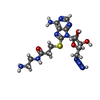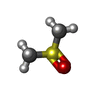[English] 日本語
 Yorodumi
Yorodumi- PDB-6fle: Crystal structure of ERK2 in complex with an adenosine derivative -
+ Open data
Open data
- Basic information
Basic information
| Entry | Database: PDB / ID: 6fle | ||||||
|---|---|---|---|---|---|---|---|
| Title | Crystal structure of ERK2 in complex with an adenosine derivative | ||||||
 Components Components | Mitogen-activated protein kinase 1 | ||||||
 Keywords Keywords |  TRANSFERASE / TRANSFERASE /  SERINE/THREONINE-PROTEIN KINASE SERINE/THREONINE-PROTEIN KINASE | ||||||
| Function / homology |  Function and homology information Function and homology informationphospho-PLA2 pathway / RAF-independent MAPK1/3 activation / MAPK1 (ERK2) activation / Signaling by NODAL / Frs2-mediated activation / ERK/MAPK targets / ERKs are inactivated / Activation of the AP-1 family of transcription factors / RHO GTPases Activate WASPs and WAVEs / IFNG signaling activates MAPKs ...phospho-PLA2 pathway / RAF-independent MAPK1/3 activation / MAPK1 (ERK2) activation / Signaling by NODAL / Frs2-mediated activation / ERK/MAPK targets / ERKs are inactivated / Activation of the AP-1 family of transcription factors / RHO GTPases Activate WASPs and WAVEs / IFNG signaling activates MAPKs / Negative feedback regulation of MAPK pathway / Gastrin-CREB signalling pathway via PKC and MAPK / Estrogen-dependent nuclear events downstream of ESR-membrane signaling / Golgi Cisternae Pericentriolar Stack Reorganization / Regulation of actin dynamics for phagocytic cup formation / Estrogen-stimulated signaling through PRKCZ / Growth hormone receptor signaling / Spry regulation of FGF signaling / SMAD2/SMAD3:SMAD4 heterotrimer regulates transcription / Oxidative Stress Induced Senescence / Senescence-Associated Secretory Phenotype (SASP) / Oncogene Induced Senescence / Signaling by Activin / Downregulation of SMAD2/3:SMAD4 transcriptional activity / Signal attenuation / NCAM signaling for neurite out-growth / Negative regulation of FGFR1 signaling / Negative regulation of FGFR3 signaling / Negative regulation of FGFR4 signaling / ESR-mediated signaling / Regulation of the apoptosome activity / Interferon gamma signaling / Signal transduction by L1 / Negative regulation of FGFR2 signaling / RHO GTPases Activate NADPH Oxidases / Negative regulation of MAPK pathway / FCERI mediated MAPK activation / PI5P, PP2A and IER3 Regulate PI3K/AKT Signaling / Regulation of HSF1-mediated heat shock response / MAP2K and MAPK activation / diadenosine tetraphosphate biosynthetic process / Recycling pathway of L1 / neural crest cell development / cardiac neural crest cell development involved in heart development / caveolin-mediated endocytosis / cytosine metabolic process / response to epidermal growth factor / mitogen-activated protein kinase kinase kinase binding / regulation of cellular pH / positive regulation of macrophage proliferation / outer ear morphogenesis / Thrombin signalling through proteinase activated receptors (PARs) / RAF/MAP kinase cascade / regulation of Golgi inheritance / ERBB signaling pathway / labyrinthine layer blood vessel development / mammary gland epithelial cell proliferation / Neutrophil degranulation / trachea formation / regulation of cytoskeleton organization / regulation of early endosome to late endosome transport / cellular response to organic substance / regulation of stress-activated MAPK cascade / positive regulation of macrophage chemotaxis / response to exogenous dsRNA / lung morphogenesis / ERBB2-ERBB3 signaling pathway / face development / androgen receptor signaling pathway /  pseudopodium / progesterone receptor signaling pathway / positive regulation of telomere capping / negative regulation of cell differentiation / Bergmann glial cell differentiation / thyroid gland development / pseudopodium / progesterone receptor signaling pathway / positive regulation of telomere capping / negative regulation of cell differentiation / Bergmann glial cell differentiation / thyroid gland development /  decidualization / steroid hormone mediated signaling pathway / decidualization / steroid hormone mediated signaling pathway /  regulation of ossification / regulation of ossification /  MAP kinase activity / MAP kinase activity /  phosphatase binding / phosphatase binding /  mitogen-activated protein kinase / stress-activated MAPK cascade / Schwann cell development / sensory perception of pain / lipopolysaccharide-mediated signaling pathway / positive regulation of cardiac muscle cell proliferation / ERK1 and ERK2 cascade / cellular response to cadmium ion / positive regulation of telomere maintenance via telomerase / cellular response to amino acid starvation / mitogen-activated protein kinase / stress-activated MAPK cascade / Schwann cell development / sensory perception of pain / lipopolysaccharide-mediated signaling pathway / positive regulation of cardiac muscle cell proliferation / ERK1 and ERK2 cascade / cellular response to cadmium ion / positive regulation of telomere maintenance via telomerase / cellular response to amino acid starvation /  myelination / dendrite cytoplasm / phosphotyrosine residue binding / RNA polymerase II CTD heptapeptide repeat kinase activity / insulin-like growth factor receptor signaling pathway / positive regulation of translation / thymus development / positive regulation of peptidyl-threonine phosphorylation / response to nicotine / long-term synaptic potentiation myelination / dendrite cytoplasm / phosphotyrosine residue binding / RNA polymerase II CTD heptapeptide repeat kinase activity / insulin-like growth factor receptor signaling pathway / positive regulation of translation / thymus development / positive regulation of peptidyl-threonine phosphorylation / response to nicotine / long-term synaptic potentiationSimilarity search - Function | ||||||
| Biological species |   Rattus norvegicus (Norway rat) Rattus norvegicus (Norway rat) | ||||||
| Method |  X-RAY DIFFRACTION / X-RAY DIFFRACTION /  SYNCHROTRON / SYNCHROTRON /  MOLECULAR REPLACEMENT / Resolution: 1.48 Å MOLECULAR REPLACEMENT / Resolution: 1.48 Å | ||||||
 Authors Authors | Gelin, M. / Labesse, G. | ||||||
| Funding support |  France, 1items France, 1items
| ||||||
 Citation Citation |  Journal: To be published Journal: To be publishedTitle: Crystal structure of ERK2 in complex with an adenosine derivative Authors: Gelin, M. / Pochet, S. / Labesse, G. | ||||||
| History |
|
- Structure visualization
Structure visualization
| Structure viewer | Molecule:  Molmil Molmil Jmol/JSmol Jmol/JSmol |
|---|
- Downloads & links
Downloads & links
- Download
Download
| PDBx/mmCIF format |  6fle.cif.gz 6fle.cif.gz | 171.6 KB | Display |  PDBx/mmCIF format PDBx/mmCIF format |
|---|---|---|---|---|
| PDB format |  pdb6fle.ent.gz pdb6fle.ent.gz | 133.9 KB | Display |  PDB format PDB format |
| PDBx/mmJSON format |  6fle.json.gz 6fle.json.gz | Tree view |  PDBx/mmJSON format PDBx/mmJSON format | |
| Others |  Other downloads Other downloads |
-Validation report
| Arichive directory |  https://data.pdbj.org/pub/pdb/validation_reports/fl/6fle https://data.pdbj.org/pub/pdb/validation_reports/fl/6fle ftp://data.pdbj.org/pub/pdb/validation_reports/fl/6fle ftp://data.pdbj.org/pub/pdb/validation_reports/fl/6fle | HTTPS FTP |
|---|
-Related structure data
| Related structure data |  6fi3C  6fi6C  6fj0C  6fjbC  6fjzC  3qyzS S: Starting model for refinement C: citing same article ( |
|---|---|
| Similar structure data |
- Links
Links
- Assembly
Assembly
| Deposited unit | 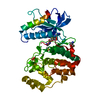
| ||||||||
|---|---|---|---|---|---|---|---|---|---|
| 1 |
| ||||||||
| Unit cell |
|
- Components
Components
| #1: Protein | Mass: 42235.547 Da / Num. of mol.: 1 Source method: isolated from a genetically manipulated source Source: (gene. exp.)   Rattus norvegicus (Norway rat) / Gene: Mapk1, Erk2, Mapk, Prkm1 / Production host: Rattus norvegicus (Norway rat) / Gene: Mapk1, Erk2, Mapk, Prkm1 / Production host:   Escherichia coli (E. coli) Escherichia coli (E. coli)References: UniProt: P63086,  mitogen-activated protein kinase mitogen-activated protein kinase |
|---|---|
| #2: Chemical | ChemComp-SO4 /  Sulfate Sulfate |
| #3: Chemical | ChemComp-DQ2 / [( |
| #4: Chemical | ChemComp-DMS /  Dimethyl sulfoxide Dimethyl sulfoxide |
| #5: Water | ChemComp-HOH /  Water Water |
-Experimental details
-Experiment
| Experiment | Method:  X-RAY DIFFRACTION / Number of used crystals: 1 X-RAY DIFFRACTION / Number of used crystals: 1 |
|---|
- Sample preparation
Sample preparation
| Crystal | Density Matthews: 2.29 Å3/Da / Density % sol: 46.2 % |
|---|---|
Crystal grow | Temperature: 291 K / Method: vapor diffusion, hanging drop / pH: 6.5 Details: PEG MME 2000, 0.1M MES pH 6.5, 0.1M ammonium sulfate, 0.02M beta-mercaptoethanol, 0.002M magnesium sulfate |
-Data collection
| Diffraction | Mean temperature: 100 K | ||||||||||||||||||||||||||||||||||||||||||||||||||||||||||||||||||||||||||||||||||||||||||||||||||||||||||||||||||||||||||||||||||||||||||||||||||||||||||||||||||||||||||||||||||||||||||||||||||||||||||||||||||
|---|---|---|---|---|---|---|---|---|---|---|---|---|---|---|---|---|---|---|---|---|---|---|---|---|---|---|---|---|---|---|---|---|---|---|---|---|---|---|---|---|---|---|---|---|---|---|---|---|---|---|---|---|---|---|---|---|---|---|---|---|---|---|---|---|---|---|---|---|---|---|---|---|---|---|---|---|---|---|---|---|---|---|---|---|---|---|---|---|---|---|---|---|---|---|---|---|---|---|---|---|---|---|---|---|---|---|---|---|---|---|---|---|---|---|---|---|---|---|---|---|---|---|---|---|---|---|---|---|---|---|---|---|---|---|---|---|---|---|---|---|---|---|---|---|---|---|---|---|---|---|---|---|---|---|---|---|---|---|---|---|---|---|---|---|---|---|---|---|---|---|---|---|---|---|---|---|---|---|---|---|---|---|---|---|---|---|---|---|---|---|---|---|---|---|---|---|---|---|---|---|---|---|---|---|---|---|---|---|---|---|---|
| Diffraction source | Source:  SYNCHROTRON / Site: SYNCHROTRON / Site:  ESRF ESRF  / Beamline: MASSIF-3 / Wavelength: 0.9677 Å / Beamline: MASSIF-3 / Wavelength: 0.9677 Å | ||||||||||||||||||||||||||||||||||||||||||||||||||||||||||||||||||||||||||||||||||||||||||||||||||||||||||||||||||||||||||||||||||||||||||||||||||||||||||||||||||||||||||||||||||||||||||||||||||||||||||||||||||
| Detector | Type: DECTRIS EIGER X 4M / Detector: PIXEL / Date: Jul 25, 2016 | ||||||||||||||||||||||||||||||||||||||||||||||||||||||||||||||||||||||||||||||||||||||||||||||||||||||||||||||||||||||||||||||||||||||||||||||||||||||||||||||||||||||||||||||||||||||||||||||||||||||||||||||||||
| Radiation | Protocol: SINGLE WAVELENGTH / Monochromatic (M) / Laue (L): M / Scattering type: x-ray | ||||||||||||||||||||||||||||||||||||||||||||||||||||||||||||||||||||||||||||||||||||||||||||||||||||||||||||||||||||||||||||||||||||||||||||||||||||||||||||||||||||||||||||||||||||||||||||||||||||||||||||||||||
| Radiation wavelength | Wavelength : 0.9677 Å / Relative weight: 1 : 0.9677 Å / Relative weight: 1 | ||||||||||||||||||||||||||||||||||||||||||||||||||||||||||||||||||||||||||||||||||||||||||||||||||||||||||||||||||||||||||||||||||||||||||||||||||||||||||||||||||||||||||||||||||||||||||||||||||||||||||||||||||
| Reflection | Resolution: 1.48→38.571 Å / Num. obs: 59645 / % possible obs: 94.1 % / Redundancy: 5.609 % / Biso Wilson estimate: 23.05 Å2 / CC1/2: 0.999 / Rmerge(I) obs: 0.038 / Rrim(I) all: 0.042 / Χ2: 0.994 / Net I/σ(I): 18.99 / Num. measured all: 334576 | ||||||||||||||||||||||||||||||||||||||||||||||||||||||||||||||||||||||||||||||||||||||||||||||||||||||||||||||||||||||||||||||||||||||||||||||||||||||||||||||||||||||||||||||||||||||||||||||||||||||||||||||||||
| Reflection shell | Diffraction-ID: 1
|
- Processing
Processing
| Software |
| ||||||||||||||||||||||||||||||||||||||||||||||||||||||||||||||||||||||||||||||||||||||||||||||||||||||||||||||||||||||||||||||||||||||||||||||||||||||||||
|---|---|---|---|---|---|---|---|---|---|---|---|---|---|---|---|---|---|---|---|---|---|---|---|---|---|---|---|---|---|---|---|---|---|---|---|---|---|---|---|---|---|---|---|---|---|---|---|---|---|---|---|---|---|---|---|---|---|---|---|---|---|---|---|---|---|---|---|---|---|---|---|---|---|---|---|---|---|---|---|---|---|---|---|---|---|---|---|---|---|---|---|---|---|---|---|---|---|---|---|---|---|---|---|---|---|---|---|---|---|---|---|---|---|---|---|---|---|---|---|---|---|---|---|---|---|---|---|---|---|---|---|---|---|---|---|---|---|---|---|---|---|---|---|---|---|---|---|---|---|---|---|---|---|---|---|
| Refinement | Method to determine structure : :  MOLECULAR REPLACEMENT MOLECULAR REPLACEMENTStarting model: 3QYZ Resolution: 1.48→38.571 Å / SU ML: 0.15 / Cross valid method: THROUGHOUT / σ(F): 1.36 / Phase error: 19.01 / Stereochemistry target values: ML
| ||||||||||||||||||||||||||||||||||||||||||||||||||||||||||||||||||||||||||||||||||||||||||||||||||||||||||||||||||||||||||||||||||||||||||||||||||||||||||
| Solvent computation | Shrinkage radii: 0.9 Å / VDW probe radii: 1.11 Å / Solvent model: FLAT BULK SOLVENT MODEL | ||||||||||||||||||||||||||||||||||||||||||||||||||||||||||||||||||||||||||||||||||||||||||||||||||||||||||||||||||||||||||||||||||||||||||||||||||||||||||
| Displacement parameters | Biso max: 107.38 Å2 / Biso mean: 36.0822 Å2 / Biso min: 14.85 Å2 | ||||||||||||||||||||||||||||||||||||||||||||||||||||||||||||||||||||||||||||||||||||||||||||||||||||||||||||||||||||||||||||||||||||||||||||||||||||||||||
| Refinement step | Cycle: final / Resolution: 1.48→38.571 Å
| ||||||||||||||||||||||||||||||||||||||||||||||||||||||||||||||||||||||||||||||||||||||||||||||||||||||||||||||||||||||||||||||||||||||||||||||||||||||||||
| LS refinement shell | Refine-ID: X-RAY DIFFRACTION / Rfactor Rfree error: 0 / Total num. of bins used: 21
|
 Movie
Movie Controller
Controller


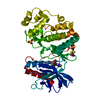
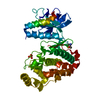


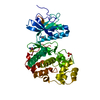

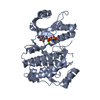



 PDBj
PDBj













